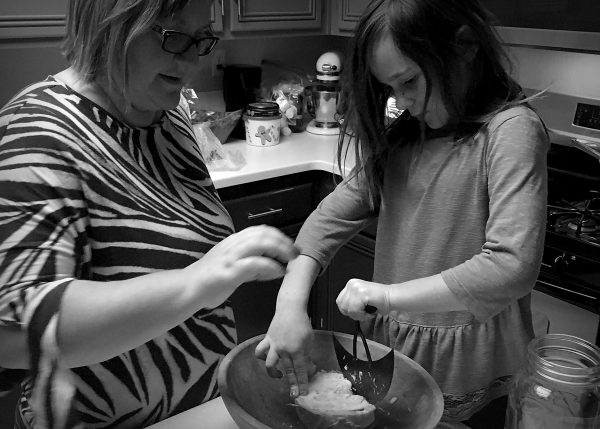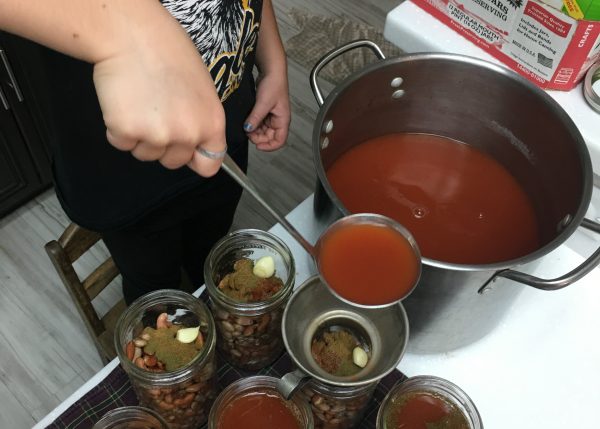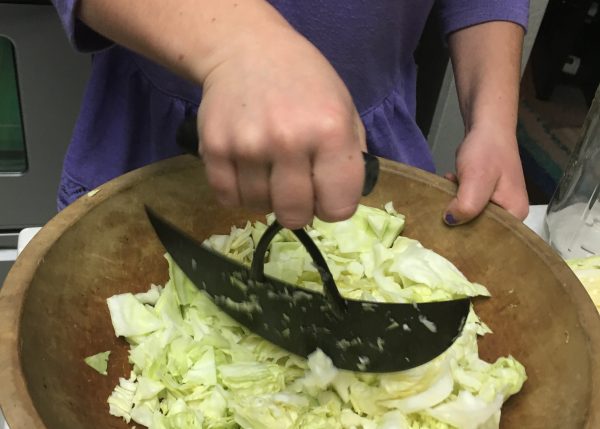There comes a point at the end of a Michigan winter when most of us are either bored, stir-crazy, or just plain depressed. Instead, try approaching it with a fresh attitude and show the winter blues who’s boss. Learn a new technique that will fill your cup and your hours. Let’s keep our minds active and our bodies busy, so we can focus on surviving winter. Canning, dehydrating, and fermenting foods are some kitchen hobbies I do with my kids to pass the time during the winter months.
Long-haul kitchen projects happen regularly in our house. Every single activity in the kitchen is a learning opportunity and a memory made. Children of all ages can perform tasks although only you can determine what yours are capable of. Set an expectation that it’s not all going to be a group effort. Plan ahead so you know when to involve the children and how much time to set aside. Starting a new kitchen hobby together now will pave the way for many hours of bonding time over the months and years ahead.
I know it might sound a bit scary. Think of it as a little (OK, big) something to keep you occupied while waiting for spring. It truly is not that hard to learn with some studying and commitment. If you can follow a recipe, you can do it! My top spots for daily reading and learning are Facebook groups and blogs. There is a wealth of information that people are sharing every day. Jump on in to one of these three unique kitchen hobbies to keep you actively surviving winter.
Surviving Winter: Canning
I grew up canning with my mom, and we still spend weekends doing it together. It’s a wonderful lesson in science for kids and adults. Just like we help our children come up with methods, hypotheses, and conclusions for science fair projects, there are actual scientists out there conducting those same types of experiments with canning to determine what is safe and what is not. The National Center for Home Food Preservation (NCHFP) has done extensive testing and provides clear recipes and instructions with an easily searchable website. Read up on botulism, so you understand the importance of using proper methods. Follow tested recipes, and your canning projects will turn out just fine.
Waterbath canning of high-acid foods like jams and pickles is the easiest place to start. A simple strawberry jam just takes an afternoon of work. Don’t worry too much about in-season produce for now as frozen fruit swaps for fresh in most jam and jelly recipes. For the savory and salty lovers in the family, many fresh vegetables can be pickled. Dilly Beans are a kid favorite. Keep in mind that not every recipe you find online is safe, so outside of the NCHFP, you can find more unique recipes from reputable sources like Ball or Bernardin. Once you have a few recipes under your belt, you may opt to read up on pressure canning for low-acid foods and really start to have fun building your pantry.
Aside from canning jars with new lids, you don’t need a whole lot of new equipment for waterbath canning. You probably already have a large soup pot that can be used as a waterbath kettle, or hit the thrift store to find bargains. For lifting jars into and out of the water, jar lifters are just a few dollars. A canning funnel is pretty handy for a couple more bucks. To get started, that’s about all it takes!
Surviving Winter: Dehydrating
One of my favorite treats as a child during Michigan winters was hot cocoa with those awesome little crunchy marshmallows. I would always pick them out and eat them before I added water. Imagine my excitement when I learned I could make those nostalgic yummies myself simply by dehydrating mini marshmallows. Now, I often have to remind myself that I don’t own a dehydrator for marshmallows alone.
Drying foods is not as intensely scientific as canning or fermenting. While the NCHFP has documentation and processes laid out for everything from fruits and leathers to vegetables and jerkies, dehydrating foods is more about methods than recipes. I save a lot of canning scraps, like tomato skins, to dry and grind into powders. Many more bags of spinach than I care to admit have been saved from the compost bin by drying. Making powders is perfect for adding to smoothies or hiding in sauces to sneak extra nutrients into my picky eater’s meals. Dehydrated foods make great snacks, seasonings, and more. They are also just right for backpacking or camping. 21st Century Simple Living is a wealth of information with wonderful tutorials and recipes for creative dehydrating.
Before shelling out for the convenience of having a new dehydrator, you can actually do most drying in your oven. As long as your oven temp will go as low as 140 (120 is even better), you’re all set to get started. Research to find out what kind of pre-treatment may be needed as lemon juice or citric acid soaks are very common among fruits and some vegetables. Most grocery stores with a decent canning section carry citric acid, and a small jar will last a long time. If you’ve never considered dehydrating, I think you’ll be surprised at the number of ways you can work it into daily life.
Surviving Winter: Fermenting
Outgassing and burping are common terms used in fermentation– which pretty much guarantees a few laughs with the kids, right? Fermenting really isn’t for the faint of heart. This is for the true kitchen nerd who wants to learn about bacteria and doesn’t mind funky smells. It’s also great for older kids who might actually need a science fair idea. While canning science focuses on ways to inhibit bacterial growth, fermenting science relies on bacterial growth. Don’t let that give you the heeby-jeebies; remember that yogurt, sourdough bread, and wine all exist because of good-for-us bacteria.
Fermented foods are rich in probiotics and support gut health, which is more important than you may realize. This is one of the reasons I began with making sauerkraut several years ago. Read this detailed explanation of honey ferments, and you’ll understand why it’s a staple in our pantry, and so very easy for the kids to do. The world of fermentation is densely layered with recipes from hot sauces to kombucha. It’s common to master one fermentation process yet know nothing about another. For a range of easy to complex recipes, I regularly head to the bookshelf for my copy of Fermented Vegetables by Kristen K. Shockey and Christopher Shockey. Delving deeper, I have enjoyed following the teachings of Sandor Katz, a self-proclaimed “fermentation revivalist.”
Fermentation is a rabbit-hole for recipes and methods, and such is the same for equipment and tools. I have and use kraut tools handmade by my great, great, great grandfather in the 1800s. The truth is, you don’t need anything fancy to start. Screw-on lids left a little loose will allow gasses to escape instead of purchasing specialty lids. You can ferment in a mason jar, and a heavy rock wrapped in Saran Wrap can act as a weight to keep vegetables under brine. I’ll never forget my almost 90-year-old grandpa expressing his confusion over having found a rock in the sauerkraut I gave him. If the hobby takes hold, maybe one day you’ll add to your toolbox.
Which one will you start?
Go bravely into the kitchen, my friends. Learn a new hobby that you and your family can grow with for years to come. Some projects can take weeks or months to come to fruition, and the reward is in the tasting– a great way to keep everyone interested all winter long. Have questions? I am happy to help! Comment here or follow me on Facebook at Jessica’s Kitchen.














